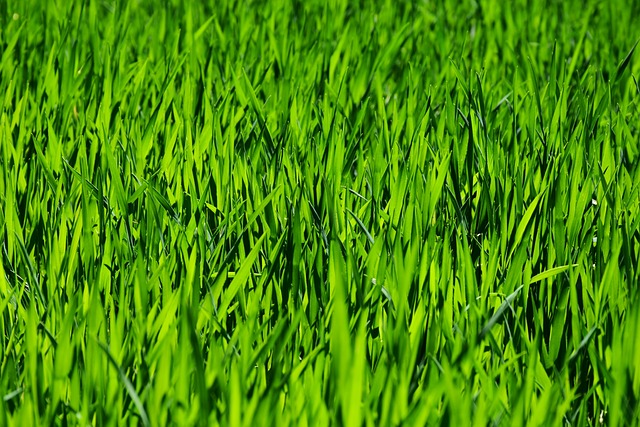To optimize your lawn care and landscaping with an efficient irrigation system, it's essential to tailor the design to your yard's unique characteristics such as terrain, soil composition, sun exposure, and plant types. This ensures uniform moisture distribution, especially on slopes, and conserves water by aligning with each soil's absorption rate. For instance, zoned watering adapts to areas with different sun exposure needs. Professional irrigation design services can provide custom solutions that consider all these factors, as well as existing landscaping features like flower beds or gardens. By selecting compatible components—including a reliable water source, pipes, valves, sprinkler heads, and timers—and adhering to local regulations during installation, you can set up an automated system that minimizes water waste and promotes sustainable practices. Enhance your lawn's appearance at night by integrating landscape lighting into the design for both aesthetic appeal and safety. Incorporating smart controllers that adjust to weather conditions further conserves water. Ultimately, a well-designed irrigation system, informed by careful consideration of your lawn care and landscaping needs, can lead to a healthy, green yard while being cost-effective and environmentally responsible.
title: Maximizing Your Lawn’s Potential with Strategic Irrigation System Installation
As summer’s heat waves and spring’s early bloomers transition into autumn’s crisp mornings, ensuring your lawn remains lush and vibrant year-round is paramount. This article delves into the essential aspects of installing an effective irrigation system tailored to your lawn’s unique needs. From assessing your landscape’s specific requirements to selecting the optimal components and materials for your irrigation setup, we guide you through a comprehensive process designed to enhance your lawn care and landscaping practices. With expert insights and practical steps, learn how to install a residential irrigation system that conserves water, promotes plant health, and elevates your outdoor space’s aesthetics, all while integrating key lawn care and landscaping principles for sustainable garden management.
- Assessing Your Lawn's Needs for Effective Irrigation System Installation
- Step-by-Step Guide to Installing a Residential Irrigation System
- Choosing the Right Irrigation System Components and Materials for Optimal Lawn Care and Landscaping
Assessing Your Lawn's Needs for Effective Irrigation System Installation

When considering the installation of an irrigation system for optimal lawn care, understanding your lawn’s specific needs is paramount for efficient water usage and healthy grass growth. A thorough assessment of your lawn’s terrain, soil composition, sun exposure, and plant types will guide the design of an effective irrigation system. For instance, slopes may require a different approach than flat areas to prevent runoff and ensure even moisture distribution. Soil type influences water absorption rates, necessitating adjustments in irrigation schedules and water pressure settings. Similarly, varying sun exposure across your lawn means different zones might need different watering frequencies. By utilizing professional irrigation system design services, homeowners can tailor their irrigation setup to the unique characteristics of their yard, ensuring that every square inch receives the precise amount of water it needs for optimal growth and minimal waste. Landscaping considerations, such as the placement of flower beds or garden areas, also impact irrigation requirements, highlighting the importance of a customized approach to lawn care through strategic irrigation system installation. Implementing a system that accounts for these variables can lead to significant savings on water bills, promote sustainability, and maintain a lush, green landscape throughout the growing season.
Step-by-Step Guide to Installing a Residential Irrigation System

A well-designed residential irrigation system is integral to maintaining a healthy, vibrant lawn and landscape. Installing such a system requires careful planning and attention to detail to ensure efficient water usage and optimal coverage for your outdoor spaces. To begin, assess your yard’s layout, topography, soil type, and plant varieties to determine the best locations for sprinkler heads. This will help in designing a system that delivers the right amount of water to each area of your lawn and garden.
Once you have a clear plan, select appropriate irrigation components, including a water source, pipes, valves, sprinkler heads, and timers. Ensure all materials are compatible with one another and meet local codes. Start the installation by excavating trenches where pipes will be laid. Use PVC or flexible poly tubing to transport water from the source to each zone of your irrigation system. Connect the pipes to the water supply, install shut-off valves at strategic points for maintenance and repair, and place the sprinkler heads according to the coverage area they are designed for. After the layout is complete, connect the system to a timer or controller to automate the watering schedule. Finally, backfill the trenches and test each zone of your new irrigation system for proper function and adjustment. Remember to incorporate landscape lighting ideas into the design if you wish to enhance the aesthetics of your yard at night while ensuring the safety of your outdoor spaces. With a step-by-step approach, you can create an efficient residential irrigation system that will keep your lawn care and landscaping efforts thriving with minimal effort.
Choosing the Right Irrigation System Components and Materials for Optimal Lawn Care and Landscaping

When installing an irrigation system for optimal lawn care and landscaping, selecting the appropriate components and materials is paramount. The right system ensures efficient water usage, promotes plant health, and can reduce overall water bills. Begin by assessing your specific landscape needs, including the types of plants and soil conditions present, as these factors influence the best irrigation setup for your property. For instance, drip irrigation might be ideal for a garden with delicate flowers, while a sprinkler system could be more suitable for a large, open lawn.
Invest in high-quality materials such as durable pipes, reliable valves, and water-efficient nozzles to ensure longevity and effectiveness. Employ a variety of emitter types for different zones to cater to the diverse water requirements across your landscape. Additionally, consider installing smart controllers that utilize weather data to adjust watering schedules, thus conserving water during rainy periods or reducing evaporation during hot spells. By carefully choosing the right components and materials, you can create an irrigation system that not only enhances the aesthetics of your lawn and landscaping but also supports sustainable water management practices.
Effective lawn care and landscaping hinge on the precise installation and maintenance of an irrigation system tailored to your specific needs. This article has provided a comprehensive guide, from evaluating your lawn’s unique requirements to selecting the optimal components and materials for your irrigation setup. By following the detailed steps outlined, you can ensure your lawn receives the right amount of water at the right time, promoting healthy growth and vibrant landscaping. With these insights, homeowners can now manage their lawn care with confidence, contributing to a lush, thriving outdoor space that reflects the care and attention given to it.




